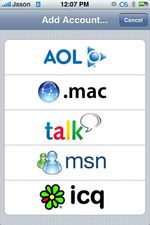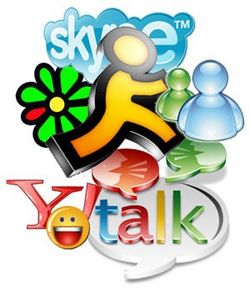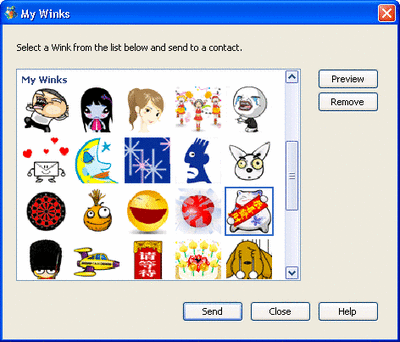T18 Group6
Contents
Group Members
Kyla Udy, Shirley Vu, Zhan Xu, Giulietta Yue
Introduction
Topic
Issue Statement
Instant messangers have come a long way in the history of telecommunications with computers. Instant messangers provide users a free, easy to use way of communicating with others. It is convient to use and has many features to enhance the interaction of two or more users. Though instant messangers can be convient and useful, it does have its drawbacks. One of the big issues with using instant messangers is that it leads to miscommunication and misinformation between users. This can happen when people use internet slang. Another issue that leads to miscommunication and misinformation is the psychological effects that occur when people are not talking face to face.
History of Instant Messangers
Instant messengers have advanced a long way from the beginning. Nowadays video camera capabilities, audio speaker capabilities and SMS related components make it easier for people to communicate from different places using instant messengers. So, for a clearer understanding, Windows Msn Messenger is used as an example to show the development and progress of instant messengers.
Before Microsoft had developed Windows Msn Messenger, the messenger was named Msn Messenger and Msn Messenger Service before that. These are the previous versions of Windows Msn Messenger, and they provide a great detail of why more and more people choose instant messaging to communicate.
Microsoft released their first version of Msn Messenger in 1999, and they named the messenger Msn Messenger Service. It was also providing access to AOL’s instant messenger network, so people who had an AOL account could also communicate through the Msn Messenger Service. The first major update was on November, 26, 1999. This provided customized chat window interface, and an updated advertising banner which rotated. The next updated version of the Msn Messenger Service included PC-to-PC and PC-to-phone audio functions.
The next era of the instant messenger, was changed drastically. The messenger itself was renamed to Msn Messenger and it also had the ability to gather contacts into a group, and enhanced voice conversations.
Two years later, version 6.0 was released on July, 17, 2003. Microsoft advanced the look of the messenger, making it more sophisticated and professional. These details included customizable emotions, display pictures, and changeable backgrounds in the conversation windows. Later versions of the 6.0 messenger also included details of changing the theme color, and provided a more customizable conversation window, such as hiding the window frame and menu bar.
In the year 2005, version 7.0-7.5 was released. Microsoft wanted to improve more on the features in the messenger, so they created wink features, animated display pictures, animated emotions and backgrounds. These features aloud the users to experience another way of communicating with their friends and family. Near the end of version 7.5 the messenger was updated to support 15 second voice clips that could be delivered to the recipient. This feature could be useful if users were tired of typing or what their typing is not clearly understandable.
On December, 13, 2005, Msn Messenger was renamed to Windows Live Messenger, and it’s very first version was released. Throughout this phase, the Windows Live Messenger yet again, has improved on the messenger interface, window conversations interface with different theme colors, and offline messaging.
The current version of Windows Live Messenger currently is 8.5. Which was last released on November, 6 of 2007. The current version did not change drastically from the former versions of the Messenger. Throughout the evolution of the instant messenger, major changes were noticed in versions, 4.6, 6.0 and 7.0
Windows Live Messenger 9.0 is the messenger in developing. Even though the messenger has been leaked and tested, the official release has not been set. One of the features Microsoft is hoping to add to this edition is multiple video chat.
Internet Slang
Beginnings
Internet slang didn't start out as internet at all. In fact, it started before the internet even existed. The origins of internet slang can be traced back to hackers in the 1970s. Hackers those days would communicate using shortened words and acronyms. Back then, only hackers knew the meanings to these words and acronyms. In 1975, the Jargon File was created by Raphael Finkel, which was a collection of hacker slangs. As new hacker slangs emerged, the Jargon File grew, and by 1990, the Jargon File had many of the modern slangs used today, such as "BTW" and "FYI".
Now
The main reason internet slang became as popular as they are today is because people could save keystrokes when typing online. For a gamer, this would not only save keystrokes, but saves time as well, since there isn't really time to type when gaming. When a person want to say "be right back", the person need 13 keystrokes to type it. The internet slang for "be right back" is "brb" which only needs 3 keystrokes, thus saving 10 keystrokes. When gaming, 10 keystrokes could be the difference between getting the kill or getting killed.
Internet slang is very useful and convient, but like all slang, internet slang is not universal, which would lead to misinformation and miscommunication. This occurs often, when a person doesn't know what the internet slang means. A conversation between those who use internet slang and those who do not can become very confusing for those who do not understand and annoying for those who do understand for having to explain what each and every single slang means. Another way that internet slang can lead to miscommunication is that some internet slangs have different meanings to them. Depending on the person and how they interpret it, an internet slang can be offending to them.
Take "lol" for example. Although it's a fairly well known slang, some meanings of "lol' is less known. While most people will agree that "lol" would "laugh(ing) out loud", there are other meanings for "lol". "Lots of laughs/laughter" is an uncommon meaning of "lol". An even rarer meaning of "lol" is "lots of love". Although "laugh out loud" and "lots of laughs" have generally the same meaning, a person could be referring to "lots of love" when they use "lol" online, which creates confusion in conversations.
Another type of internet slang is 1337 or "leetspeak". It started out as a hacker slang as well. Hackers would replace letters of words with numbers and symbols to communicate to each other. Since only a few individuals knew this slang, they referred to themselves to be elite. "Eleet" which is derived from elite, soon became more common amongst these hackers. Since leetspeak uses numbers and symbols to replace letters, "eleet" would be "31337" which is how 1337 came into existance. When people start to use 1337 to communicate, converstations can become very confusing, which is why not many people use 1337.
Psychological Effects
Sending a simple email to a friend can end up in a mess. When you are typing, you cannot express sarcasm and can come across as arrogant or rude. In turn, giving you a co worker that is unimpressed and ultimately torn between confronting the situation face to face, or acting on impulse and replying to the email or instant message in the heat of anger and frustration. These actions are becoming more apparent with the emergence of social neuroscience, the study of what happens in the brains of people as they interact. New findings have discovered a design flaw at the point where the brain encounters a computer screen.
While you can have the uncertainty of human reactions through email, researchers have discovered that the face to face human interactions are information rich, in these interactions you can read the person that you are speaking to; for changes in tone, body language and emotions that are used to describe the situation in the context.
The benefits of technological communication are numerous, especially as university students, many of us moved from home and in order to keep in touch with friends and family back home we send emails, instant messages and texts. When we write messages we consider our words, with emotion as we type our message to our friends or family. However the person or persons’ you are sending the message to may not take the context of the message the same as you had intended it. Sometimes, people can also misread people’s reactions to their messages when the person receiving the message doesn’t respond right away to their emails, if they don’t check their inbox all of the time. Some people don’t always have their phone, therefore don’t respond to text messages or they are slow typers while on msn.
This problem isn’t just in the communication between personal relationships it also exists in professional relationships. With the generation gaps in the workplace, younger coworkers have grown up in the age of technology. Older coworkers and many executive members had to learn about how computers and instant messaging works at a later time in their life. This generation gap has led to many different problems in the workplace. Many baby boomers are having trouble keeping the attention of their younger coworkers, many younger generation workers are finding that their coworkers are over explaining concepts, therefore losing the attention of their coworkers. This reaction many believe is in part due to with the different types of technology available to Generation Y (those born between 1977-1989) in their childhood learning.
Research is going into seeing if the brains of the more technologically advanced generation vary from that of the Baby Boomers. Proof is in the way generation Y can process large amounts of information in small periods of time. This is proved through how they ask short questions through email, instant message or text, wanting short and direct answers. In this fashion they try to avoid face to face conversations because they don’t have the verbal communication skills that the older baby boomer generation was required to discover in early childhood.
Instant Messangers Today
References
Udy
http://www.nytimes.com/2007/10/07/jobs/07pre.html?_r=2&ref=technology&oref=slogin&oref=slogin
http://wistechnology.com/articles/1414/
http://blacktable.com/imhandbook.htm#ch2
http://www.spring.org.uk/2007/10/avoid-email-miscommunication.php
http://www.articlesbase.com/advice-articles/miscommunication-root-cause-of-problems-66753.html
http://ezinearticles.com/?Why-Miscommunication-Creates-Personal-Conflict&id=84224
http://www.stanford.edu/class/pwr3-25/group2/pdfs/IM_Social.pdf
Vu
Xu
http://www.bbc.co.uk/dna/h2g2/A787917
http://en.wikipedia.org/wiki/Leet
http://en.wikipedia.org/wiki/Internet_slang
http://en.wiktionary.org/wiki/Appendix:Internet_slang
http://en.wikipedia.org/wiki/Instant_messaging
http://en.wikipedia.org/wiki/Jargon_file
www.flight1337.com/ lolz/1337_3.jpg
Yue
http://en.wikipedia.org/wiki/Windows_Messenger
www.msncontentplus.cn/images/winksscreenshot_lar.gif
www.cybernetnews.com/wp-content/uploads/2007/12/instant-messengers.jpg
www.jasoncypret.com/wp-content/uploads/2008/mobile-chat.JPG



